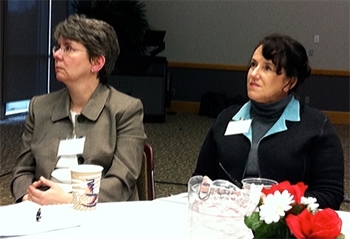Illinois ARRA Broadband Awardees Looking to the Future of Internet in Illinois
By Lou Carlozo
Published: March 7, 2011
 NAPERVILLE, Illinois, March 7, 2011 – While others bemoaned what the Great Recession might do to halt all progress on the broadband front, two Illinois-bred politicians—Gov. Pat Quinn and President Barack Obama—were already working to turn the Land of Lincoln into a land that’s digitally linked in.
NAPERVILLE, Illinois, March 7, 2011 – While others bemoaned what the Great Recession might do to halt all progress on the broadband front, two Illinois-bred politicians—Gov. Pat Quinn and President Barack Obama—were already working to turn the Land of Lincoln into a land that’s digitally linked in.
The fruits of their combined efforts, as witnessed by close to 100 state leaders from the public and private sector, were in evidence Monday at Northern Illinois University’s Naperville campus, as Broadbandillinois.org hosted presentations by four awardees at its regional meeting.
At a time when parts of Illinois remain out of the broadband loop—thus effecting everything from emergency services to educational resources—the meeting couldn’t come at a more opportune time.
“It’s not just building a fiber network,” said John Lewis, director of NIU’s Regional Development Institute and a host for Monday’s event, which drew more than 50 movers and shakers from the Illinois broadband community. “It a huge public investment, and we need to be able to see a return on that investment to convince Congress they made a good decision.”
Lewis was also one of the four presenters Monday, and by “good decision,” he was referring to President Obama’s efforts to keep broadband access growing in Illinois, and nationwide, through the American Recovery and Reinvestment Act of 2009 (ARRA).
Thanks to ARRA, Illinois landed $245 million in competitive federal funds to maximize the impact of broadband statewide. State and private sources, including $26 million from the Illinois Jobs Now! capital program, make up more than $109 million of the total broadband budget, now exceeding $350 million. What’s more, Illinois outpaces most states in broadband progress thanks to Gov. Quinn, who commissioned a state report on universal broadband access in 2004, as lieutenant governor.
As the first presenter, Lewis discussed his ongoing efforts to organize and create market research into the current broadband supply and demand structures in DeKalb County and the 9 other counties that make up the northwest Illinois Broadband Opportunity Partnership (IBOP).
Showing a map of the 830-mile network criss-crossing his region, Lewis explained the four goals of his work: to increase access to broadband; provide access to consumers in under-served areas; increase access and opportunities for public education and health care facilities; stimulate the use of broadband for job growth and economic growth.
In case anyone missed the “jobs” part, Lewis amplified it: “That’s the bottom line; what happens to the gross county product and measuring the impact of [broadband] investment,” Lewis said, “If you look at our projects, they’ll serve close to a million people and 300,000 households.”
Lewis also predicted a project completion of August 2013 for broadband work under the northwest Broadband Opportunities Program work (BTOP). So what will the impact be to state citizens? “This may be 5 to 10 years out before you can measure it,” Lewis said. “Has it created new business? Has it created jobs? Are households using it? But if we wait two to three years to collect the data, we won’t have good baseline data.”
Next up Charles Wu (a Chicago South Suburbs Round 2 BIP winner) discussed how Convergence Technologies of Burr Ridge discussed how he’s working to build out services to not just the lucrative, but vastly underserved areas of his region. What might’ve been a $3 million broadband expansion project without government funding will now exceed $12 million—thanks to $8 million in grants from the Broadband Infrastructure Program (BIP), and $4 million of private, in-kind matching for middle mile and last mile services.
He also repeated Lewis’ jobs refrain: “This will also increase our job creation to the point where we can add 20 to 30 new jobs a year, [a jump of] more than 200 to 300 percent,” Wu said. “I need people all across the board; I have 50 employees and when we feel the pain, we go out and get more. Broadband is creating more jobs.”
Wu created 13 new jobs and increased CTI’s pre-tax earnings by $1.5 million during the “jobless recovery” of 2010. “We had some humble beginnings 10 years ago, as college students in the frat use,” Wu said. “Since then, we’ve come a long way. We have more than 3500 business customers and as a for-profit business, we’re looking for where there’s a bang for the buck. We’re covering 700,000 households, and the way we look at it, there’s a market opportunity of $50 million here. Let’s get into the market and figure things out.”
 From the City of Chicago, Matthew Guilford talked about the Smart Communities Program is addressing barriers to broadband use. “This is much as electricity was a century ago,” Guilford said. “It is essential for the economic vitality of our city. But more than 40 percent of people in the city do not have broadband access in their homes.”
From the City of Chicago, Matthew Guilford talked about the Smart Communities Program is addressing barriers to broadband use. “This is much as electricity was a century ago,” Guilford said. “It is essential for the economic vitality of our city. But more than 40 percent of people in the city do not have broadband access in their homes.”
To that end, the city will spend $7.1 million in total BTOP funds for sustainable broadband adoption, with an additional $9 million for public computer centers to build “digital excellence.” And to expand broadband, the city is looking at four of its most underserved neighborhoods as test beds: Chicago Lawn, Englewood, Humboldt Park and Pilsen. These are also neighborhoods that, to varying degrees, have problems with crime and poverty that regularly make headlines.
“We just ordered 677 new work stations for our youth workforce and community centers,” Guilford said, adding that the city also hopes too offer digital skills courses in Spanish, Polish and Chinese to serve the city’s immigrant population.
Finally, Andrew Lowenstein of Connected Living spoke about how his company will work its $4.7 million broadband funding (as a Round 2 BTOP SBA winner) to get low-income seniors and disabled people online.
“Seniors in general lag behind the rest of the population; 49 percent 65 and over don’t use broadband,” Lowenstein said. “Since we’re all the way from Chicago out west to the Quad Cities, we are urban and suburban, and we have all sorts of ethnicities.”
Lowenstein noted: “A state-of-the-art broadband program will create a backbone in the community; not only are we creating education and a path out of poverty, but we’re making these communities more self-sufficient as well.”
Photos by Lou Carlozo